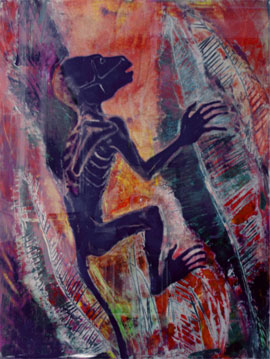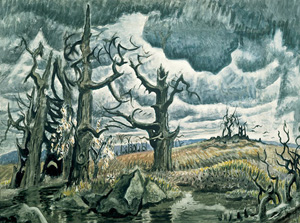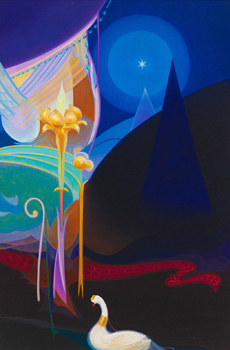Frankly a Visionary
John Haberin New York City
Mary Frank, Charles Burchfield, and Agnes Pelton
Mary Frank is not just a visionary. Neither was Charles Burchfield, back when Modernism was just bringing art back to earth. Yet showing them together brings alive their most unearthly twentieth-century visions.
For Agnes Pelton, everything in nature held a deeper significance, so why not a place to live? She had studied art in New York and Massachusetts when she chose as her home Water Mill, on eastern Long Island. She later moved to an even smaller community in California, Cathedral City, near Palm Springs. Coincidence? They must have sounded ever so right for someone who painted celestial arches and journeys on the river of life. The Whitney presents her as a neglected woman artist, a visionary, and a "Desert Transcendentalist." 
His own private apocalypse
Mary Frank has always had an eye on planet earth. She studied with Max Beckmann, the artist who refused to look away from Germany in the 1930s, even after Beckmann's exile in America. And then she studied life drawing in New York with Hans Hofmann, the teacher of Jackson Pollock, Lee Krasner, and Albert Kotin. She has stood out among artists less than half her age in a 2009 group show of "Natural Histories." She returns now to painting after a decade of photography with an eye to nature—her surroundings at home in the Catskills. That return, though, marks even her most naturalistic subjects as not altogether of this world.
It hardly hurts to see her, from the 1980s right up to the present, beside work by Charles Burchfield from his mid-twenties. They may seem an unlikely pair—the Midwesterner and the Englishwoman, the aspiring artist in 1917 and the artist still active today at eighty-six, watercolors and paintings literally set in stone. The gallery considers them two separate shows, with Burchfield first, although they share a room and even a wall. Still, his New England shades easily into her upstate New York, his views of the seasons into her timeless narratives, and his dark storms and fiery fields into her steady intensity. In context, her new work looks even newer.
In a 2010 Burchfield retrospective at the Whitney, one could see how nature for him served as his own private apocalypse (and I invite you to read more at the link for a closer look), but the turn began early. He could not have exemplified the American modern in 1917, because he was still creating it, and he never cared much for familiar forms or formalism anyway—not even at his closest to abstraction. His stalks and trees ascend into the air as if of their own volition. And Frank's figures rarely set foot on the ground, not even in stone. Unlike Lois Dodd on the ground, they find refuge where they can in the nooks and crannies of a very material sky.
Born in 1893 in Ohio and educated in Cleveland, Burchfield, too, settled in upstate New York and out of the public eye. In photographs, he looks like a small-town accountant, hair partly neatly in the middle and collar neatly stayed. Yet he never outgrew a child's encounter with nature (and do allow me to borrow from the earlier review to explain). He kept hearing Church Bells Ringing, Rainy Winter Night and The Insect Chorus before dawn, to quote just two of his early titles. He seems never to have gotten over childhood fears of chasms in the woods. His late watercolors mingle elation, Gothic fantasy, and a serious touch of Disney yet to come.
The subjects themselves sound like paradigms of lost time—Afternoon in the Grove, Garden of Memories, The Song of Katydids on an August Morning. They also sound idyllic, but this is not the New England utopia of Looking Backward, published five years before Burchfield was born. Where Edward Bellamy's vision was socialist, Burchfield is always isolated. He has one far-away city, more or less unreachable, in black silhouettes spotted by eerie white reflections of clouds or attic windows, a little like a bombing run. He has a grand total of two people, including a woman in "crabbed old age" framed by the blackness of an open doorway and her garden of memories. The other, the artist's mother, is also dark and blurry, like a haunting.
Nature has a way of hovering ominously, like a huge cloud over a dead-vertical storm. A bare tree gnarled like a Gothic tower looms in the distance, and The Night Wind stirs cloud shapes into ghosts. Humanity, though, is worse. Mostly it, too, does a lot of looming, like eaves peeking out above dense trees arching the insect chorus. A Romanesque tower rises behind wheat fields and bare clearing, crossed by rigid streaks of sun and shadow. A mine pit ruins a willow grove.
Letting the fish go
Frank became known first for sculpture—with one eye on the human form, one eye on Modernism, and an inner eye on her doubts about both. A woman's head may break off into planes, as in Cubism, or seem on the brink of melting away. Its features may look defiant or heartbreakingly and vulnerable, but more often both at once. An example turns up in "Making Knowing" at the Whitney, a show of craft in American art since 1950, and another in the back room here, but as only a prelude to painting. There the hints of Cubism are gone, and women are rarely alone. In fact, they are not half as clearly human.
Small paintings on shale-like stone work well enough on their own, but on a shelf together they set out her vocabulary and a single natural history. The figures in black or white include birds, reptiles, primates, and humans—or an evolutionary stage in between. A man and woman, huddled together on canvas, have not altogether lost their fur. Stone fragments turn up in the larger paintings, too, along with additional strips of canvas, for a layering of materials and thoughts. Wavy incisions into thick white bring out the texture of paint, but also the material weight of art itself or that sky. With a predominance of red, the air may have caught on fire as well.
Her monoprint in "Natural Histories" had a deep red, too—its humanoid monkey, I wrote then, bent like a fossil in mystic contemplation. Frank's subjects now are still fossils and still mystical, but they can no longer stay still long enough to contemplate anything, whether the great beyond or their fate on earth. They leap, swim, float, or sink as in an apocalypse or a dream. Two may appear to confront one another from opposing sides of a diptych,  unless one is too busy dragging behind her a fish. After "I caught an enormous fish," Elizabeth Bishop in poetry "looked into his eyes" and had to let the fish go. Frank cannot let go of anything in pursuit of her vision.
unless one is too busy dragging behind her a fish. After "I caught an enormous fish," Elizabeth Bishop in poetry "looked into his eyes" and had to let the fish go. Frank cannot let go of anything in pursuit of her vision.
They may appear to transcend barriers or to be caught up in them. One leaping woman has just left a huge rock, in hope of landing on another. Will she find herself instead shattered by its crags or drowning in the sea below? A family forges slowly ahead along an endless highway. If their nudity stands for a shared intimacy, it makes even clearer their vulnerability and isolation. Their lean gray flesh has nothing in common with art's classic nudes—just as their family ties have nothing in common with accommodating women since Titian.
Another nude finds more encouragement in a highway by dominating it. Running into the picture, away from the viewer, she asserts her independence. It speaks, too, to Frank's own self-assertion that figures apart from couples are invariably women. Yet what looks like still another path ahead is merely the top of the Great Wall. Its long parapet could serve as a prison. It is and is not a dream of freedom.
Frank keeps repeating the same motifs because she is actively forging a vision. That gray flesh picks up the tone of the slate on which she paints. Her most ambitious painting here brings her motifs together in those fragments of gray against that fiery red and swirling incised white. The figures to every side may not acknowledge one another, but they belong to a single circumferential swirl as well. Their often prehistoric nature links her natural history to something older than herself or Modernism. Still, like an unplowed field for Burchfield, it unfolds within a present-day imagining, where neither she nor her subject can let go.
The river of a Woman's life
Agnes Pelton sought communities on the edge, as apart from the mainstream and closer to nature. Early on she painted young women alone, seeking both what lies right in front of them and something more. Her retrospective opens in 1917, with Room Decoration in Purple and Gray, which sounds more modest than it looks. A woman in black faces a tree filled with birds and flowers—their soft, light colors close to her face and hair. Her crossed arms convey humility, even as the free curves of the sky carry her into her dream. Before long the female figures are gone, but the dreams and their symbolism remain.
The show's title aside, Long Island gets plenty of rain, and even Palm Spring has 98 percent humidity as I write. Besides, Pelton had a cosmopolitan background indeed. Born to Americans in Berlin in 1881, she passed her childhood in three European cities before her father died of an overdose and her mother brought her to Brooklyn. From that moment on, she must have felt the need for completion and a fear of the pleasures of this world. She exhibited in the 1913 Armory Show and at an influential New York gallery, worked on commission, and found a revelation in Toward the Spiritual in Art, the manifesto of abstraction by Wassily Kandinsky. She had the same art teacher as Georgia O'Keeffe—and, with her near abstract landscapes, much the same subject. 
Like O'Keeffe, Pelton also passed through New Mexico and its desert, where she joined the short-lived Transcendental Painting Group. The Whitney does not so much as name its other members, since you are unlikely to have heard of them. She sought transcendence all the same, by any means necessary. She studied yoga, and a blue figure floating in a yellow aura from 1933 echoes Buddhist art. She also painted two leading lights of theosophy, the woman awfully bland and the man downright sinister. She could well have fallen victim to a cult.
Thankfully, they proved mostly a detour. Her colors had darkened for a handful of abstract paintings from the mid-1920s, and they do again as her symbolism returns. Even the sun or moon on the horizon can take on a deep blue. A favorite from 1931 in the Whitney's collection could sum up her symbolic language, which hardly changes before her death in 1961. A swan floats along a blood-red river, while a yellow flowers rise into a night sky crossed by radiance,like encroaching darkness for Emily Nelligan, toward a single bright star. Nearly white pillars and arches often point up as well. The sky itself can end in flames.
How far-seeing were her visions? Pelton took from Kandinsky more the "spiritual" than the "toward," as static symbolism goes with increasingly static paintings. Her flowers have neither O'Keeffe's naturalism nor close-ups pushing oil on canvas into all-over painting. The work is modern enough, with nested or overlapping circles not all that far from Robert Delaunay and Stanton Macdonald-Wright. Still, it also looks back to an older candidate for the invention of abstraction, the symbolism of Hilma af Klint. An early and more conservative work, not in the show, looks back further still—to Joan of Arc's vision in a garden, by Jules Bastien-Lepage in 1879, which (judging by her reversal of it) she may have seen in a print. At least Pelton's Joan floats in right over the garden, herself part of the vision.
The curators, Gilbert Vicario of the Phoenix Art Museum and Barbara Haskell with Sarah Humphreville, may have af Klint in mind. They claim another precursor of so much modern art, for all her elaborate picture frames. They must see a woman's forgotten journey in such titles as The Primal Wing, Awakening, Ecstasy, Ascent (Liberation), and Resurgence. Still, they settle for a modest selection of forty-five paintings, and not all of its vaguely sexualized figures stand out. Some do, like the swan—and so does Pelton's subject, mystic contemplation. It can hold you even if you do not altogether share her vision.

Mary Frank and Charles Burchfield ran at D. C. Moore through February 8, 2020, Agnes Pelton at The Whitney Museum of American Art through November 1. Related reviews look at Burchfield in retrospective and "Natural Histories," and now I also catch up with Frank's latest work in late spring. Portions of this review first appeared in a slightly different form in Riot Material magazine.




